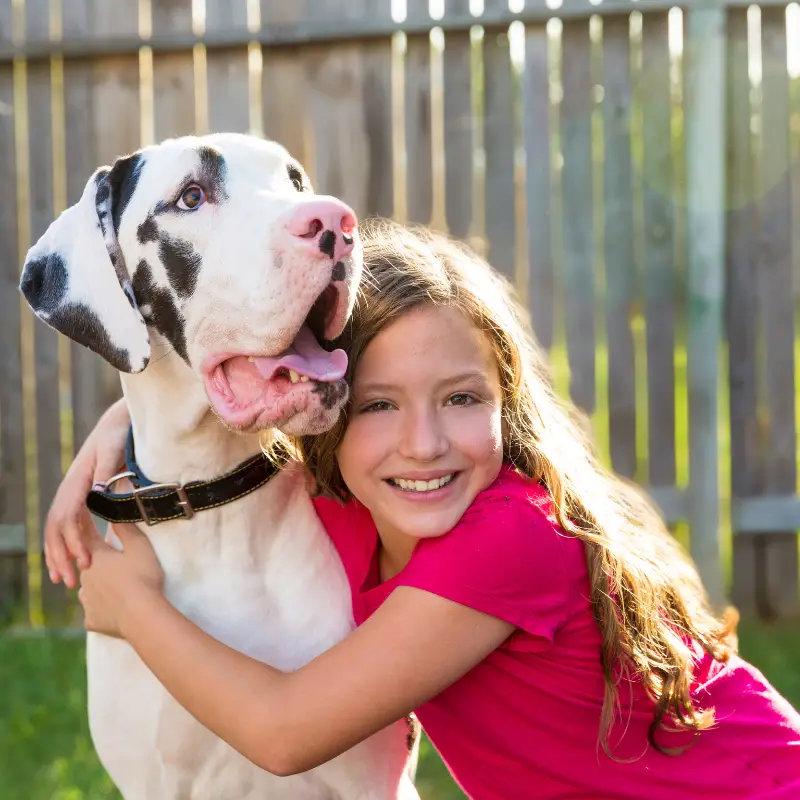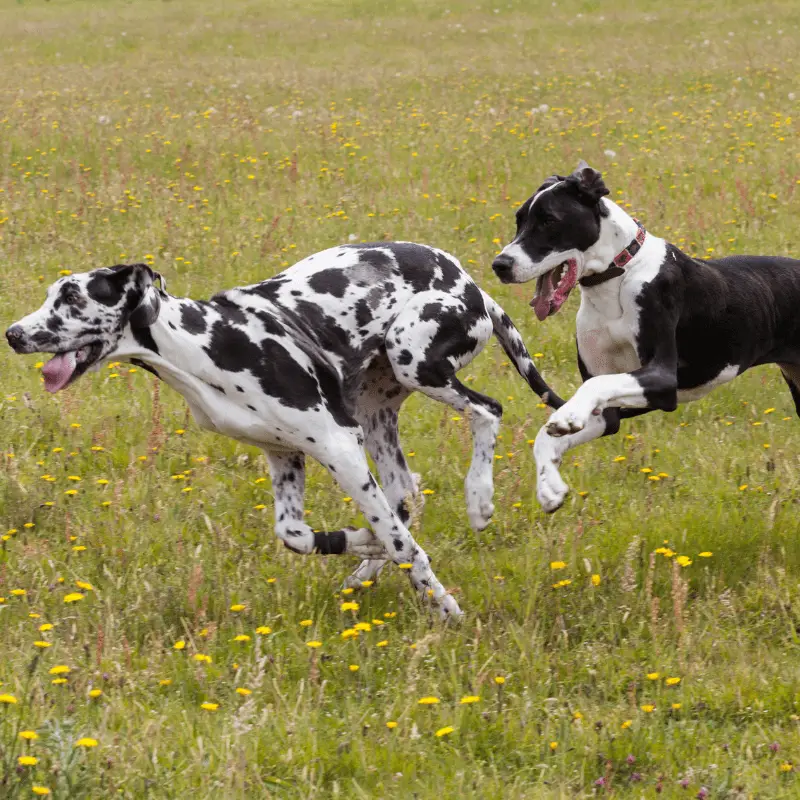Are you a dog lover? Do you love big dogs or small ones? If you are in love with the larger dogs, then surely Great Danes will win your heart. With a 32 inches shoulder height, the Great Danes enjoy a towering presence over most other dogs. When the Danes stand on their hind legs, they can even reach beyond your head.
Most people tend to link the size of the dog with its fierceness; the Great Danes present a precisely opposite picture to that belief. Even with their vast build, these dogs give a picture of balanced temperament and elegance. The easy and smooth stride of these dogs will make you remember the attitudes of the noblemen.
Even though the coats of the dog come in different colours, the best-known coat of the Great Danes comes in the white and black patchwork. This type of coat pattern of the Great Dane is known as the harlequin.
Being sweet and calm, Great Danes make great home dogs. For most intruders, just the sight of the dogs is enough to deter them from committing any crime. However, if anyone takes the sweet and friendly nature of the dogs for granted, the History of the Great Dane indicates that they will be shocked at the spirit and courage these dogs can show. The Great Danes are perfect and patient when it comes to kids. They are mostly people pleasers who try to become successful in making friends.

History
Great Dane is yet another breed of dog that has a long history. However, there is no streamlined version of the origin and the timeline of the Great Dane. While some argue that the dog evolved in Britain several hundred years ago, while others propagate that it was the Germans that did most of the work.
So, in most cases, the history of the Great Dane depends on the version you choose to listen. That being said, no one knows how the Great Dane dog breed became associated with Denmark. Now that we have cleared the air let’s have a look at the chronological history of the breed.
3000 BC
As we have already indicated, the Great Dane breed goes as far back as the ancient Egyptian times. There are some carvings in the ancient Egyptian tombs that resemble the build of the Great Danes. However, there is some difference of opinion among the researchers about it.
5th Century
During this time, the Alanis, an Asiatic race, was invading Europe. During this invasion, the Alanis brought giant mastiff dogs with them. It is then that for the next several hundred years, the breeders of Europe cross-bred the Irish Greyhounds with the big mastiff-like dogs. As a result, a huge but slimmer than the giant mastiffs breed had been created.
There is another version of this story. It is said that it was the Romans, who bought the giants mastiff-like dogs with them. Over the centuries, the celts cross-bred the giant mastiff-like dogs with the Irish Greyhounds or the Irish Wolfhound or with both to create a new breed of dog. This cross-breeding resulted in a new species known as the English Dogge, which is the ancestor of the Modern Day Great Dane.
That being said, it might be possible that both of this origination history is accurate. However, there is no denying that the Germans need more credit for developing the Great Danes that we know today.
16th Century
By the middle of this century, the nobles of many European countries started to import giant long-legged dogs. The history of the Great Dane indicates that these dogs were the descendants of the cross-breeds between the Mastiffs and the Irish Wolfhounds. The hybrids enjoyed the agility of the greyhounds or wolfhounds and the strength of the mastiffs. The sizes of these dog hybrids varied greatly as there were no formal breeding standards. These dogs were called the English Docke or Englischer Hund of Germany.
By the end of this century, the hybrid dogs became popular in England, and Germany, for their ability of hunting boar. The Germans, however, tried to perfect the imperfections of the breed and create better boarhounds to fulfil their requirements.
17th Century
Thanks to the boar hunting abilities of these dogs, the German nobilities started taking an interest in the breed. During this century, the ancestors of today’s Great Danes were bred in the courts of the German nobility independent of the English methods of breeding.
These dogs used to hunt deers, bear and boar with their blue-blooded masters during the day and used to take refuge in the bed chambers of their masters during the night. The german royals and monarchs tend to offer ornate collars to the dogs that were permitted to sleep with them. The fierce loyalty of these dogs helped the kings and the princes from the assassins.
During the hunt, the dogs were to chase the boars and bears down and hold them to the place until the huntsmen killed it. However, the long ears of these hounds used to get shredded, from the tusks or the claws of the boards and bears. Due to this reason, the ear clipping of the dogs was started. During this time, the ears of the dogs were clipped to give a pointy and short look. That was very different from the long cuts that we see in the modern Great Danes.
Even though different types of boar hounds were bred during this period, with the invention of the firepower, the hunting tactics changed drastically. With that, the breeding requirement of these strong and muscular dogs plummeted as well. After the advent of the guns, these dogs were only bred for companionships.

The 1800s
As the job requirements of the boar hounds changed utterly, the breeders also changed their tactics. For boar hunting, the hounds needed muscular strength and ferocity. However, once they started to stay in the bed chambers of their masters, the breeders also concentrated on the calmness of the dog.
That became even more important when the dogs were only bred as the companions. During the whole century, the breeders evolved the boar hounds into a breed of dogs that are more good-natured and friendly to people. With the complete change of the breed, the Germans felt the need to change the name of the dog as well.
1878
In this year, a committee of breeders and the dog show judges was formed in Germany that contemplated the requirements of the name change of the Englische Dogge. The committee decided that a name change is unavoidable and they named the new breed as the Deutsche Dogge changing the History of the Great Dane forever. This variation of dogs later became known as the German Mastiff or Great Dane.
1887
The American Kennel Club recognised the breed of Great Dane in this year. The Great Dane was the 34th breed that the club recognised till that time.
1891
In this year, the Great Dane Club of Germany was formed. During this time, the breeders started to talk about the modern standards of breeding.
1899
The Great Dane Club of America was formed during this year. It stoked the popularity of the dog among the citizens of the USA. Throughout this century, the dog became famous as the German boarhound in most of the English speaking nations. However, some of the breeders tried to start the name German Mastiff or German dogge in the English market. They thought that this name would indicate that these dogs do not belong to any working breed. They should instead be marked as the dog of luxury.
Later, the building tensions between the Germans and the other countries of the war, the English market rejected the name German Mastiff, and the dog became known as the Great Dane, following the name given by the french Naturalist Compte de Buffon. That’s why even though Denmark has no contribution to the history of the Great Dane, the breed carries its name.
1939-1945
Even though the hunting past and the great size of the Great Danes make people think that they could be great soldiers, the truth could not be far from the idea. Even though during WWII, the marines and army tried to train the Great Danes as the war dogs, but none of the dogs even passed the basic levels of training. It is said that on one occasion, an army training officer was moved to tears as he could not make a Great Dane jump over an obstacle. Instead of jumping over it, the Great Dane was bringing the obstacle back to the trainer time and again.
However, there was a Great Dane that was associated with the army during WWII. The British naval garrison in South Africa enrolled a Great Dane into the royal navy as their mascot.
1945-2020
Over time, the Great Danes have turned into a well mannered, regal giants from the fierce boar hunting dogs. Most Great Danes of today are good-natured and make perfect pets for families with children. Along with that, the Great Danes also used for therapy and other service dogs. The gentle bearing of the dog helps people to stay calm and conduct their day to day work without any troubles.

Conclusion
All in all, if you are searching for a pet for your home or an assistance dog, Great Danes will be a perfect choice. Despite the fierce history of the Great Dane, selective breeding has brought out the best in them. So, if you are ready to open your home and your heart to a canine companion, the Great Danes can be the best choice.
